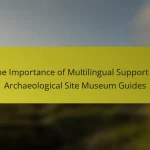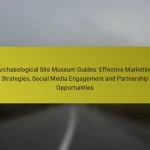As archaeological site museums evolve, they are increasingly adopting digital tourism trends to enrich visitor experiences and broaden accessibility. By leveraging advancements in technology, such as virtual reality and interactive displays, these institutions are transforming traditional exhibits into engaging, immersive environments that cater to diverse audiences.
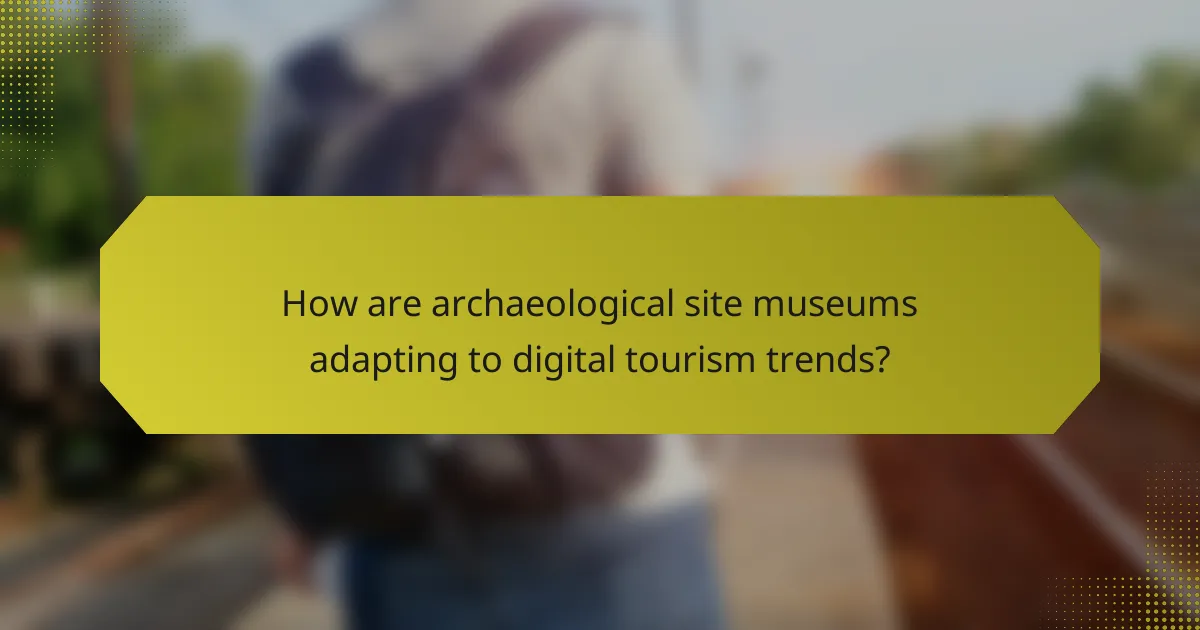
How are archaeological site museums adapting to digital tourism trends?
Archaeological site museums are increasingly embracing digital tourism trends to enhance visitor experiences and engagement. By integrating technology, these institutions are making their exhibits more accessible and interactive, catering to a broader audience.
Integration of augmented reality experiences
Augmented reality (AR) is transforming how visitors interact with archaeological artifacts and sites. Museums are using AR to overlay digital information on physical displays, allowing users to visualize historical contexts or reconstructions through their smartphones or AR glasses.
For example, a visitor could point their device at a statue and see a 3D animation of how it was originally displayed in its historical setting. This immersive experience not only educates but also captivates audiences, making visits more memorable.
Virtual tours and online exhibitions
Virtual tours and online exhibitions are becoming essential tools for museums, especially in the wake of global travel restrictions. These digital platforms allow users to explore exhibits from anywhere in the world, often featuring high-resolution images and detailed descriptions.
Many museums now offer guided virtual tours led by curators, providing insights that enhance the online experience. This approach not only broadens access but also attracts potential visitors who may later choose to visit in person.
Mobile applications for visitor engagement
Mobile applications are increasingly used by archaeological site museums to enhance visitor engagement. These apps often include interactive maps, audio guides, and educational games that encourage exploration and learning.
For instance, a museum app might feature a scavenger hunt that prompts visitors to find specific artifacts, rewarding them with insights or discounts at the gift shop. This gamification of the museum experience can significantly increase visitor satisfaction and retention.
Social media marketing strategies
Social media marketing is vital for archaeological site museums to reach and engage with potential visitors. By sharing captivating content, such as behind-the-scenes videos, artifact highlights, and visitor testimonials, museums can build a strong online presence.
Effective strategies include using targeted ads to promote upcoming events or exhibitions and encouraging user-generated content through hashtags. Engaging with followers through live Q&A sessions or virtual events can also foster a sense of community and keep the audience informed and excited about museum offerings.
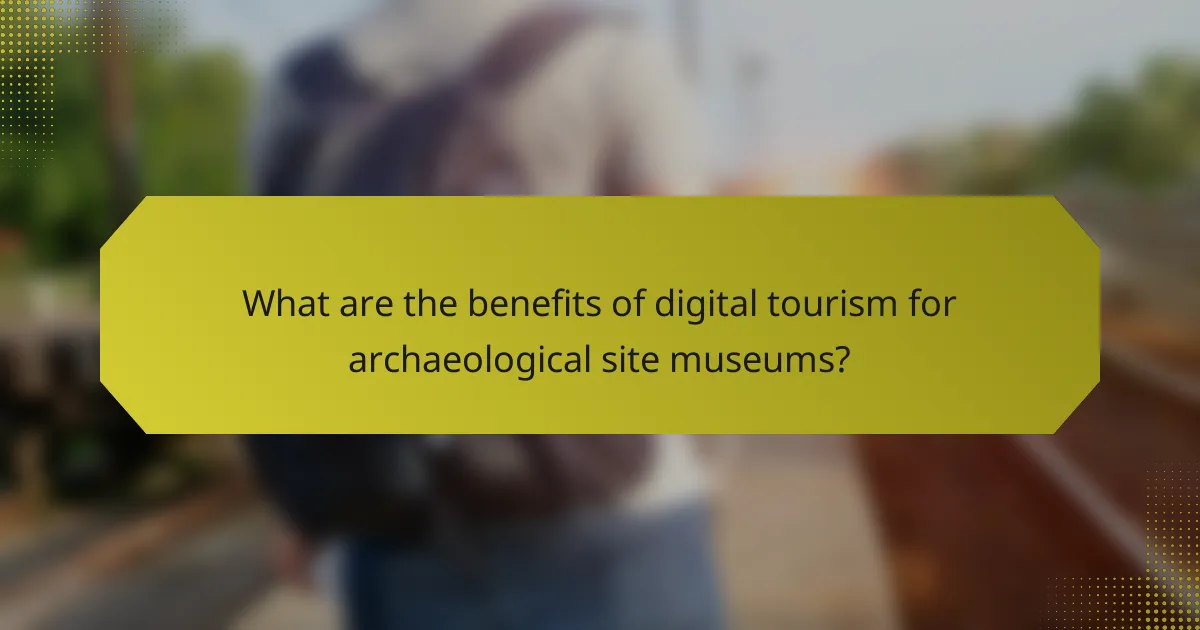
What are the benefits of digital tourism for archaeological site museums?
Digital tourism offers archaeological site museums a range of benefits, including increased accessibility, enhanced educational outreach, and improved visitor engagement. By leveraging technology, these museums can reach a broader audience and create more interactive experiences.
Increased visitor accessibility
Digital tourism significantly enhances accessibility for visitors, allowing them to explore archaeological sites remotely. Virtual tours and online exhibitions enable people with mobility challenges or those living far from the site to engage with the museum’s offerings.
Additionally, digital platforms can provide content in multiple languages, catering to international audiences. This inclusivity helps museums attract a diverse range of visitors, ultimately increasing their reach and impact.
Enhanced educational outreach
Digital tools facilitate educational outreach by providing resources that can be easily shared with schools and communities. Interactive apps and online learning modules allow educators to incorporate archaeological content into their curricula, making learning more engaging for students.
Moreover, digital platforms can host webinars and live Q&A sessions with experts, creating opportunities for deeper understanding and interaction. This approach not only informs but also inspires future generations to appreciate and protect cultural heritage.
Improved visitor engagement and retention
Digital tourism enhances visitor engagement through interactive experiences, such as augmented reality (AR) applications that bring artifacts to life. These immersive technologies can captivate visitors, encouraging them to spend more time exploring the site and its history.
To retain visitors, museums can implement loyalty programs or offer exclusive digital content for repeat visitors. Regular updates and new features keep the experience fresh, motivating guests to return and explore new offerings.
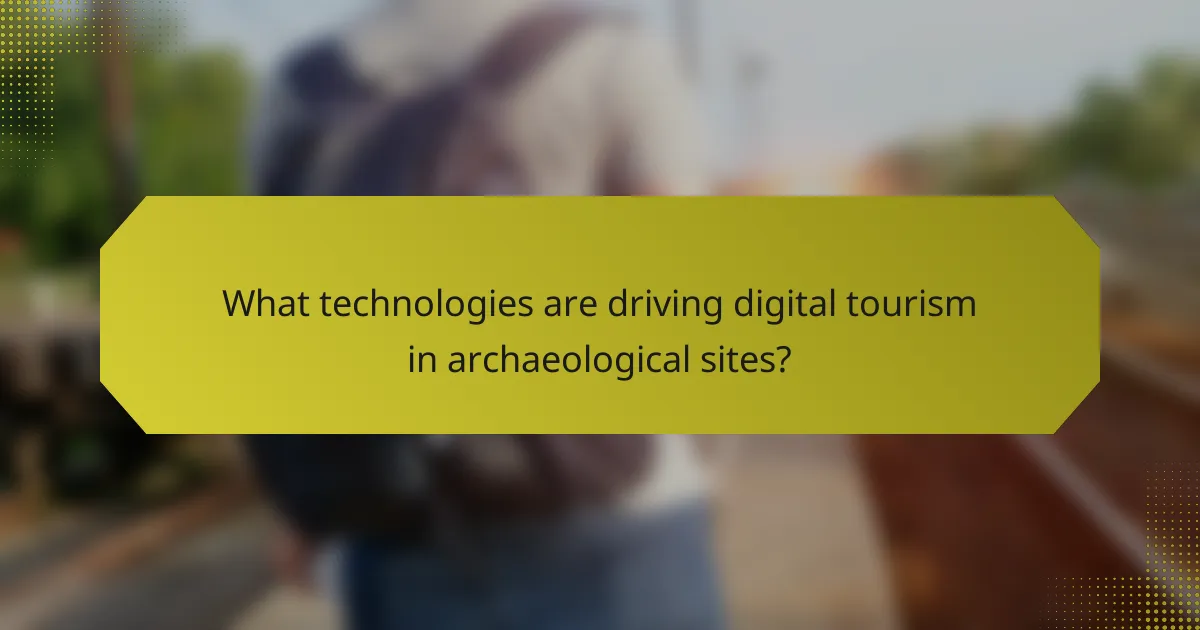
What technologies are driving digital tourism in archaeological sites?
Digital tourism in archaeological sites is primarily driven by advancements in virtual reality, interactive displays, and geolocation-based applications. These technologies enhance visitor experiences by providing immersive and informative interactions with historical artifacts and sites.
Virtual reality headsets
Virtual reality (VR) headsets offer users an immersive experience, allowing them to explore archaeological sites as if they were physically present. By simulating environments and events from the past, VR can transport visitors to ancient civilizations, enhancing their understanding and engagement.
When implementing VR, consider the hardware requirements and the need for user-friendly interfaces. Providing guided experiences can help visitors navigate complex historical narratives without feeling overwhelmed.
Interactive kiosks and displays
Interactive kiosks and displays serve as informative touchpoints within archaeological sites, allowing visitors to access detailed information about artifacts and exhibits. These installations can include touchscreens that provide multimedia content, such as videos, images, and 3D models.
To maximize effectiveness, ensure that kiosks are strategically placed and easily accessible. Regular updates to the content can keep the information fresh and relevant, encouraging repeat visits.
Geolocation-based apps
Geolocation-based apps enhance the visitor experience by providing location-specific information and guided tours. These apps can use GPS technology to deliver content tailored to the user’s current location within the archaeological site, making the exploration more interactive and informative.
When developing these apps, focus on user engagement features such as augmented reality overlays or gamification elements. It’s crucial to ensure that the app is compatible with various devices and easy to navigate, as this will improve user satisfaction and retention.
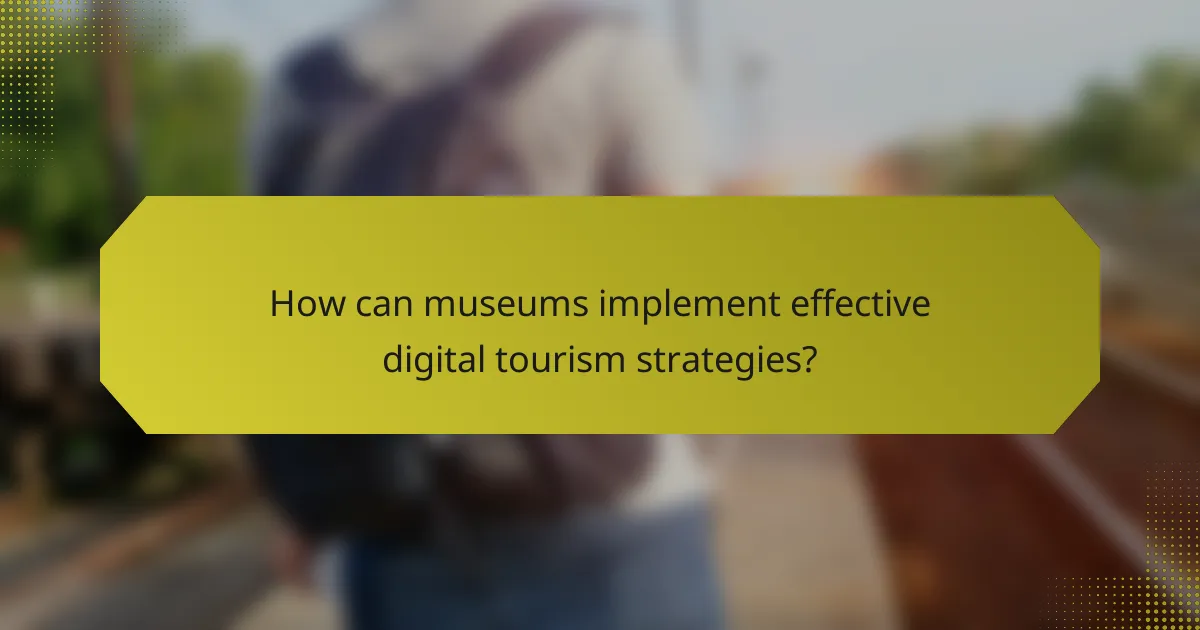
How can museums implement effective digital tourism strategies?
Museums can implement effective digital tourism strategies by integrating technology to enhance visitor engagement and streamline access to information. This involves leveraging partnerships, investing in staff capabilities, and creating accessible digital content that resonates with diverse audiences.
Partnerships with tech companies
Establishing partnerships with technology companies can provide museums with the tools and expertise needed to enhance their digital offerings. Collaborations can lead to the development of mobile apps, virtual reality experiences, and interactive exhibits that attract tech-savvy visitors.
For example, a museum could partner with a local software firm to create an augmented reality app that allows visitors to see historical artifacts in their original context. Such partnerships can also help museums stay updated with the latest technological advancements.
Investing in staff training
Investing in staff training is crucial for successfully implementing digital tourism strategies. Staff members should be equipped with the skills to manage digital tools and engage with visitors effectively. Training programs can cover topics such as digital content creation, social media engagement, and data analytics.
Regular workshops and seminars can keep staff informed about emerging technologies and best practices in digital tourism. This investment not only enhances the visitor experience but also fosters a culture of innovation within the museum.
Creating user-friendly digital content
Creating user-friendly digital content is essential for attracting and retaining visitors in a digital tourism landscape. Content should be easily accessible, engaging, and informative, catering to various audience preferences. This includes developing mobile-friendly websites, interactive guides, and multimedia resources.
For instance, museums can offer virtual tours that allow users to explore exhibits from home, complete with audio guides and interactive elements. Ensuring that content is available in multiple languages can also broaden the museum’s reach and appeal to international tourists.
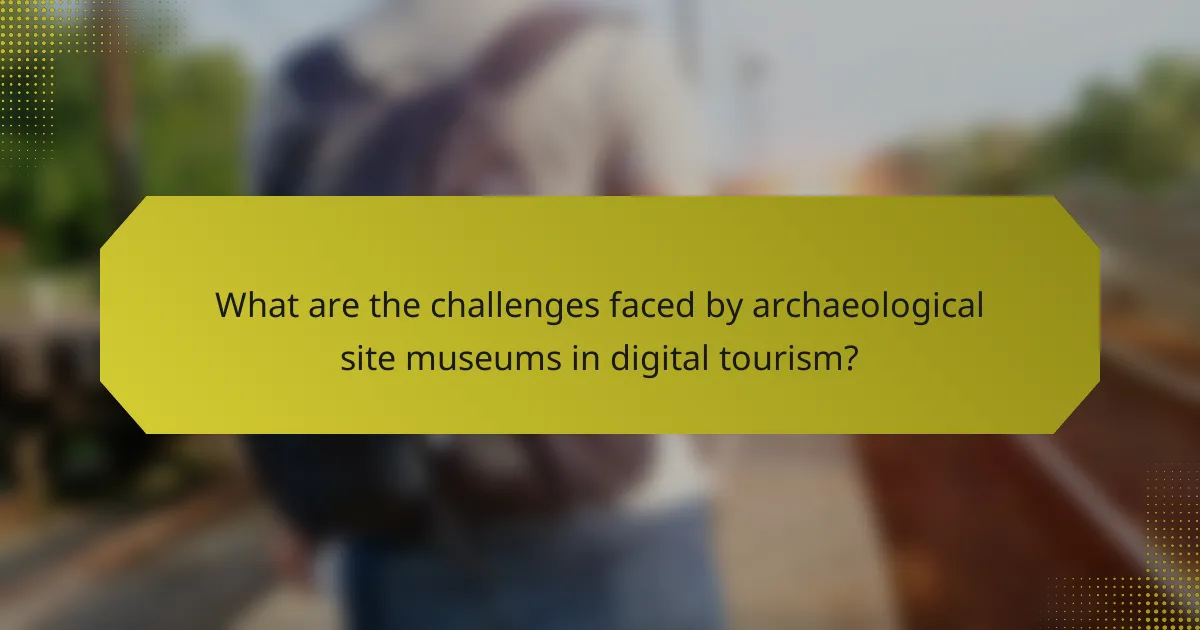
What are the challenges faced by archaeological site museums in digital tourism?
Archaeological site museums encounter several challenges in digital tourism, including budget constraints, the need for relevant content, and the integration of physical and digital experiences. These factors can hinder the effective use of technology to enhance visitor engagement and educational opportunities.
Budget constraints for technology adoption
Many archaeological site museums operate on limited budgets, making it difficult to invest in advanced digital technologies. Costs associated with hardware, software, and ongoing maintenance can quickly add up, often leading to prioritization of essential services over innovative solutions.
To manage these constraints, museums can explore partnerships with tech companies, apply for grants, or consider crowdfunding initiatives. Allocating a small percentage of their annual budget specifically for technology can also help in gradually adopting new tools.
Maintaining digital content relevance
Keeping digital content up-to-date is crucial for engaging visitors and providing accurate information. Archaeological findings and interpretations can evolve, requiring museums to regularly review and revise their digital offerings.
Establishing a content management strategy that includes regular updates and feedback from experts can help maintain relevance. Museums should also consider user-generated content, allowing visitors to contribute their insights and experiences, which can enhance the overall digital narrative.
Balancing physical and digital experiences
Finding the right balance between physical and digital experiences is essential for maximizing visitor engagement. Over-reliance on digital tools can detract from the tangible aspects of archaeological sites, while too little digital integration may fail to attract tech-savvy audiences.
Museums should aim to create a seamless experience where digital elements complement physical exhibits. For instance, augmented reality applications can enhance on-site tours without overshadowing the artifacts themselves. Regular visitor surveys can provide insights into preferences, helping museums adjust their offerings accordingly.
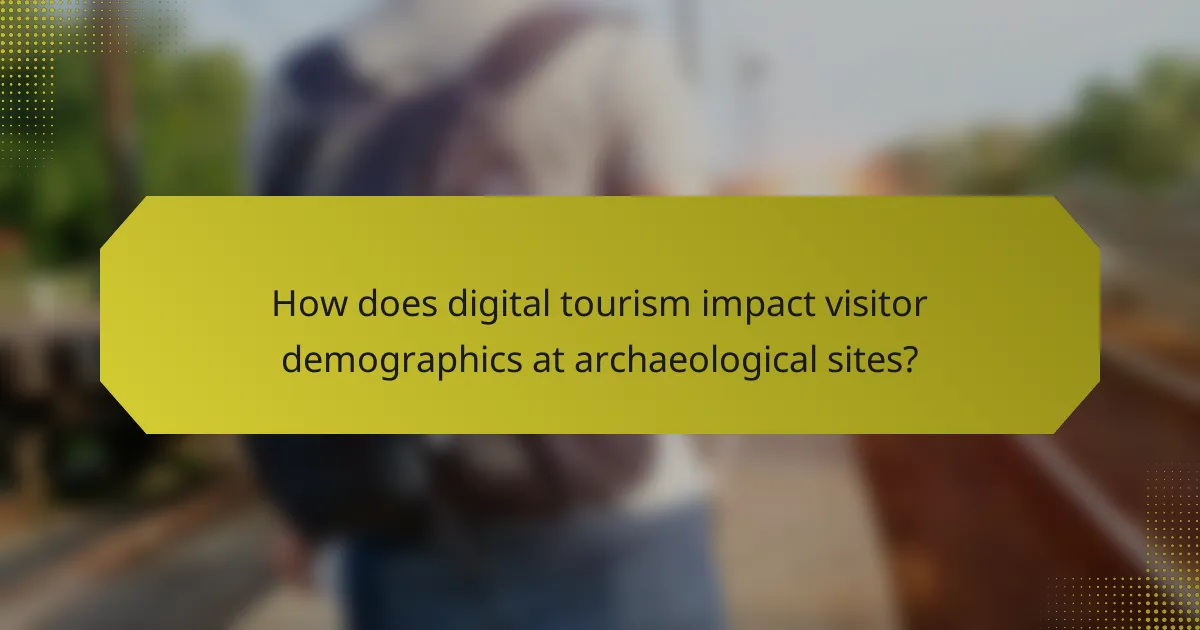
How does digital tourism impact visitor demographics at archaeological sites?
Digital tourism significantly alters visitor demographics at archaeological sites by attracting a broader and more diverse audience. Enhanced online accessibility and interactive experiences appeal to younger generations and tech-savvy travelers, increasing overall engagement.
Increased Accessibility
Digital tourism makes archaeological sites more accessible to a wider audience, including those who may not have the means to travel. Virtual tours and online exhibits allow individuals from various backgrounds to explore these sites from anywhere in the world.
For example, a virtual reality experience can simulate a visit to an ancient ruin, enabling users to engage with the site without physical constraints. This accessibility can lead to increased interest in visiting the actual site in the future.
Demographic Shifts
The integration of digital tools attracts younger visitors who are accustomed to technology in their daily lives. This shift can lead to a more diverse demographic, as younger audiences often seek interactive and immersive experiences.
Moreover, families with children may find digital resources helpful for educational purposes, making archaeological sites more appealing as family-friendly destinations. This trend can encourage repeat visits and foster a deeper appreciation for cultural heritage.
Engagement Through Technology
Technological advancements, such as mobile apps and augmented reality, enhance visitor engagement at archaeological sites. These tools provide interactive content, such as detailed site histories and 3D reconstructions, which can enrich the visitor experience.
For instance, an app that offers guided tours with multimedia content can keep visitors engaged and informed, leading to longer stays and increased satisfaction. Sites that embrace these technologies often see higher visitor retention and positive word-of-mouth promotion.

